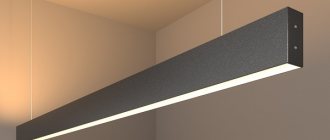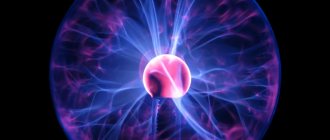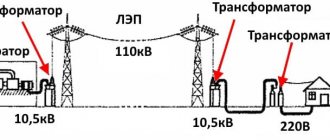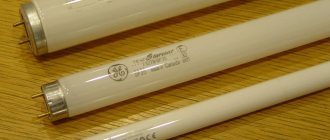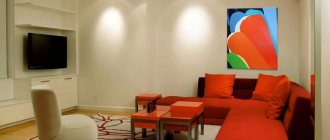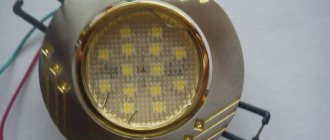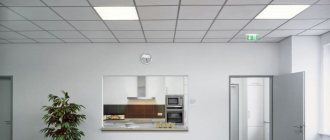There are different types of lamps on sale. To find the right one for your home or apartment, it’s worth understanding the main types and their features. Properly selected equipment not only provides good lighting, but also serves as an additional design element.
Modern models are a full-fledged decorative element.
Operating principle and design of lamps.
LED lamp design.
An LED light source consists of several elements connected in one housing. This is a base, driver, radiator, LED and light-diffusing bulb.
- The base is an element that is screwed into the socket of a chandelier or other lamp. Most often, screw bases of the E27 and E14 types are produced for domestic use. It is made of brass with a nickel anti-corrosion coating. For other needs, light sources with a pin base are available.
- Driver is an element that stabilizes the incoming voltage, converting alternating current into direct current. It also provides power to the LED. The driver consists of microcircuits, a pulse transformer, and capacitors. Inexpensive LED products may not have a driver. Instead, a simple power supply is used that does not provide current and voltage stabilization. Also, the driver is not installed in miniature light bulbs due to lack of space inside the housing.
- A radiator is an element that removes heat from LEDs and provides them with optimal operating temperature conditions. It usually forms the visible part of the housing of the lighting fixture. The radiator can be made of various materials: from expensive ceramics to cheap plastic. Aluminum and composite materials occupy an average niche: they are quite inexpensive and dissipate heat efficiently.
- A diffuser is a transparent “cap” that helps distribute light in space. It is made in the form of a hemisphere for dispersing light beams at a wide angle. The material used is polycarbonate or plastic. In addition, the diffuser prevents dust and moisture from entering the housing. To soften the harshness of the light and reduce the irritating effect on the eyes, this element is coated from the inside with a phosphor. This achieves a color temperature similar to natural light.
- LEDs are the main working element of the lamp. Due to the operation of the diode, the glow appears.
The operating principle of LED lamps is based on physical processes in semiconductors. The glow appears after an electric current passes through the contact boundary of two semiconductors (n and p), one of which should be dominated by negatively charged electrons, and the other by positively charged ions. It is worth noting that these materials only allow current to pass in one direction. When it passes into charge carriers, recombination occurs - electrons move to another energy level. As a result, light radiation visible to the eye appears. In addition to the glow, heat is also released, which is removed from the LED using a radiator.
Diagram of the appearance of optical radiation in an LED element.
In their early days, LEDs could only emit a specific wavelength of light: green, red or yellow. Therefore, LED elements were built into electrical circuits in the form of indicators. In the process of development of microelectronics, materials were found that made it possible to obtain a wide spectrum of light waves. However, this problem has not been completely solved: in the glow of LED lamps, either the blue wavelength or the red and yellow wavelength predominates. For this reason, they are divided into cold and warm, respectively.
About the importance of lighting technology
Light and sound accompaniment of events is a component of the action itself and a necessary part of the atmosphere of the event. For example, light is important for the work of artists on stage and their visibility from the audience.
It is important to have enough street lighting for driving on the road. Illumination of roads, sidewalks and public areas is a necessary part of everyday life in the city. The light will make it convenient to stay on the street at night and increase the level of safety on the roadway.
Types and types of LED lamps.
There is no clear classification for LED lamps: products are produced in too many different shapes, colors and configurations.
By method of application:
- General purpose light sources for lighting apartments and offices. Characterized by a dispersion angle from 200 to 3600.
- Directional light products. Such light bulbs are called spots. They are used to create lighting or highlight interior areas in a room.
- Linear type products, similar to conventional fluorescent lamps. Manufactured in the form of tubes. They are used in technical rooms, offices, store rooms and other spaces where fire safety is important. They create bright, beautiful lighting that will highlight the necessary details.
According to their purpose, LED lamps are divided into:
- Products for outdoor use. Manufactured in a dust- and moisture-proof housing.
- Products for industrial purposes, public utilities. Supplemented with a vandal-proof durable casing. They are manufactured with special requirements for lighting characteristics: stability, service life, operating conditions.
- Household lamps. They are characterized by low power, stylish design, electrical and fire safety, quality of luminous flux (color rendering index, pulsation coefficient, etc.).
Based on the voltage consumed, there are also three types of lamps:
- Powered by 4 V. Low-power LEDs that consume from one to 4.5 V. They emit light of different wavelengths from infrared to ultraviolet.
- Powered by 12 V. This voltage is safe for humans, so these light sources are suitable for rooms with high humidity. They are often produced with pin sockets, which complicates the connection process. An additional difficulty may be the need for a special power supply that will reduce the mains voltage to 12 V. Convenient for use by car enthusiasts and tourists: they can organize lighting from a battery.
- Powered by 220 V. The most common type. Widely used for household needs.
Types of socles.
In order for LED light sources to fit into the existing power supply scheme of houses, they are equipped with screw bases. As an alternative to halogen-type lamps, lamps with pin bases are produced. The main types are presented in the table.
| Base type | Purpose | Photo |
| E27 | The most common screw type for household light sources. | |
| E14 | Screw base for low-power lamps. | |
| E40 | Screw base for powerful light sources (mainly outdoor ones). | |
| G4 | Pin contacts for small light bulbs. | |
| GU5.3 | Pin contact for furniture and ceiling light sources. | |
| GU10 | Similar to GU5.3, but the contact spacing is 10mm. | |
| GX53 | Pin contact for flat luminaires. | |
| G13 | Contact similar to fluorescent tube lamps. |
What is a lamp
Lamps include all artificial light sources designed to illuminate indoors and open spaces . They are used for their intended purpose and for decorative purposes (highlighting part of the interior, focusing attention on individual details, illuminating the facade, etc.).
The equipment can direct the light flux to a specific place or diffuse it for uniform illumination, it all depends on the type and purpose of the lamp. Lighting elements are part of the interior design and are selected to suit the decor.
Combination of spotlights and pendant lights.
Technical characteristics and markings of LED lamps.
Many global and Russian companies produce LED light sources: OSRAM, Gauss, ASD, Philips, Navigator, ERA and others. You can read about the most popular of them in the article “Rating of LED lamps 2022”.
Before purchasing an LED lamp, you should carefully study its technical properties indicated on the packaging. There are quite a lot of them. To avoid confusion, let's look at them in more detail.
An example of marking technical properties on packages.
Power (measured in W). Shows how much electricity the lighting fixture consumes. In this parameter, LED light sources are an order of magnitude superior to incandescent lamps. The packaging indicates the actual and equivalent power. The lamp in the picture actually consumes 9 watts. It replaces a 75 W incandescent lamp. Due to this, energy savings and family budget savings are achieved.
The power of industrial and street LED light sources can reach up to 1000 W. But for domestic needs, actual power from 2 to 20 W is quite enough. For the convenience of users, special tables with equivalent capacities have been compiled.
| LED power, W | Luminescent power, W | Incandescent lamp power, W |
| 1 | 3 | 15 |
| 3 | 7 | 35 |
| 5 | 11 | 50 |
| 7 | 15 | 70 |
| 9 | 19 | 90 |
| 12 | 25 | 120 |
| 15 | 31 | 150 |
| 18 | 36 | 180 |
Luminous flux (measured in Lm). This parameter describes the brightness. To make it clearer, you can imagine the light from incandescent lamps with a power of 40, 60 and 100 W. Their luminous flux is similar to the brightness of LED elements at 400, 600 and 1000 lm, respectively. For convenience, you should remember the last couple of numbers and navigate by them: a traditional 100-watt Ilyich lamp has a brightness of 1000 lm.
Service life in hours. The number of hours that the light source will work. In this indicator, LED elements are the leaders: on average, they work 25 times more than traditional lamps.
However, it is worth keeping in mind that the brightness of the lamp directly depends on the number of hours worked. The older the lamp, the dimmer it shines. The L70 standard has been adopted worldwide. And if the packaging says that the luminous flux according to L70 is 50,000 hours, this means that after time the brightness will be only 70% of the original.
Some manufacturers indicate a long service life, but claim that they guarantee it under certain operating conditions: for example, if the lamp operates no more than three hours a day. This is also written on the packaging, but usually on the side.
Base type . The figure shows the type of base E14 - for small lamps.
Color temperature (measured in K). Characterizes the warmth of light. Due to their design features, LEDs are capable of producing a luminous flux of different heat: with a predominance of the blue spectrum or red and yellow.
Color temperature has a wide range:
- Up to 2800 K – warm yellow light with a red tint (similar to low-power incandescent lamps);
- 3000 K – warm white light with a yellow tint (analogue – halogen light sources);
- 3500 K – natural neutral white light (analogue – fluorescent lamps; color does not distort color perception, eyes do not get tired);
- 4000 K – cool white (well illuminates the space, suitable for kitchens, offices, study rooms);
- 5000-6000 K – daylight (very bright, suitable only for industrial premises);
- 6500 K and above – cold daytime with a bluish tint (used in hospitals, technical rooms, for photography and video shooting).
Color temperature of LED lamps
When choosing a color temperature for lighting a living space, it is worth noting that the lower it is, the more it promotes relaxation and tranquility. Cooler colors are invigorating and set the mood for a work environment.
Color rendering index. Determines whether there will be color distortion in the room. It is designated by the Latin letters CRI or Ra and numbers from 1 to 100. The lower its value, the greater the color distortion. At index 100 there will be no distortion at all. For use in the home, it is recommended to use lamps with a color rendering index of at least 80-90.
Overall dimensions ( indicated in mm). The dimensions of LED light sources are slightly larger than those of similar incandescent lamps. Therefore, when choosing a light bulb for a specific lampshade or lamp, do not forget to check the dimensions. Otherwise, there is a chance that it simply won’t fit where you need it.
Scattering angle. This is the angle at which light rays diverge from the source. The higher the parameter, the larger the illuminated area. Due to design features, the LED always shines mostly straight. Therefore, several LED elements are built into the lamp. Depending on their location inside the lamp body, the light dispersion angle can range from 300 to 3600.
Scattering angle.
This allows you to create both narrowly focused light fluxes and widely illuminate the room. Provides the opportunity for interesting design solutions. You should choose the dispersion angle based on the purpose of the lamp: for ceiling spots 900-1800 is enough, and for spot lighting 300 is suitable.
The packages also indicate:
- in what voltage range does the light source operate (the wider it is, the higher the likelihood that the light source, especially an inexpensive one, will not burn out during power surges);
- the ability to connect via a dimmer - indicated by this icon;
- pulsation (flicker) coefficient. Determined by the uniformity of the glow. For good LED lamps it is about 5%, which is comfortable for the eyes. Light sources with a pulsation coefficient higher than 35% should not be used.
Installation
- Suspensions are used for mounting pendant lamps. In this case, there must be a gap between the ceiling and the lamp.
- Ceiling lamps weighing less than 5 kg are fixed directly to the plasterboard material. In this case, connecting lamps in a suspended ceiling will not be possible without butterfly dowels.
- Chandeliers with a whole set of tiers should be attached only to a concrete base. The plasterboard sheet is drilled into the concrete. Next, a 10 cm hole is deepened in the concrete. This hole is filled with a mounting anchor of the appropriate diameter. After this, a special extension pin is fixed. Using a ring nut, the suspended ceiling chandelier is attached to the stud.
- Several lighting fixtures can be combined into a composition. In this case, the room will acquire an unprecedented ocean of light.
Ceiling lights for suspended ceilings will harmoniously fill any office, home or public space with light. Modern lamps can boast of their functionality, beauty and versatility. Your home will gain a dose of coziness and comfort. Modern design workshops accept orders for the creation of various types of lamps.
First of all, look through the available catalogs, websites, photo and video materials. Next, based on your taste preferences, place an order. After this, you can independently begin marking the room and installing lamps on the suspended ceiling.
How to connect an LED lamp.
The connection is similar to incandescent and fluorescent lamps - you should turn off the power to the socket and screw the lamp into it.
If you need to connect several LED light sources, the following connection options are possible: serial and parallel.
However, this connection should not be used in practice. Even LEDs from the same batch do not guarantee the same voltage drop. Because of this, the current on an individual LED element may exceed the permissible limit, which can cause the elements to fail.
The serial version requires a minimum number of wires, but is used extremely rarely. The reason for this is two shortcomings. Firstly, when one light bulb burns out, the entire circuit fails. Secondly, the lamps do not work at full power, since when connected in series, the voltage is summed up. Perhaps the only cases where a serial connection is justified are Christmas tree garlands and entrance lighting. In these cases, low power ratings for many light sources are acceptable.
The scheme is quite simple:
- from the distribution box the phase goes to the switch;
- from the switch the phase passes to the LED lamp;
- the neutral wire is connected to the second contact of the last lamp in the circuit;
- The phase wire passes from the lamps to each other.
Serial connection diagram for LED lamps.
The parallel method is used most often. The main advantage is the supply of the same voltage to all light bulbs in the circuit. In the event of a burnout, only a failed light source falls out of the circuit, which is easy to replace.
You can connect in parallel in two ways: beam and daisy chain.
The beam method is reliable. Although this requires a large amount of cable. And it is important to think about the moment of connecting all the elements. Most often, a terminal block is used for this. On one side, a phase is supplied to its jumpers. On the reverse side, connect the wires coming from the light bulbs. It is recommended to fill the inside of the terminal block with anti-oxidation paste. Also, instead of a block, use twisted wires with soldering.
Diagram of parallel beam connection via terminal block.
When using a loop circuit, the phase and neutral wires from the panel and switch are connected to the first light bulb. From it the cable is fed to the second and so on. Thus, each light bulb (except the last one) is connected to four wires: two phase and two neutral.
Diagram of parallel connection using a daisy chain circuit.
Connecting light bulbs operating on 12V voltage is similar, only a step-down transformer must be included in the circuit.
Diagram of parallel connection of 12V spotlights via a transformer.
LED connection diagram
There are several main options for connecting diodes in a lamp. This information is necessary for anyone who plans to do the installation themselves, rather than entrust the work to professional teams.
- Serial connection . A common type, most often used in industrial production. The simplest, most universal and least financially expensive scheme, due to this it remains quite vulnerable.
- Parallel connection . This circuit requires the use of current-limiting resistors, which are connected in series to each lamp, ensuring safety and stable operation.
- Mixed connection . In this case, entire blocks assembled from series-connected elements are connected in parallel. This scheme is quite versatile and is often used in homes or offices.
The choice depends on the specifics of the task and operating conditions. It is also important to remember the disadvantages of one type or another. For example, with a serial connection, the failure of one lamp will lead to an overload or break of the entire circuit.
When using a parallel connection , the breakdown of one element does not interfere with the operation of the others. At most, it affects the final power of the system. But such a connection is much more expensive.
The mixed type combines the advantages of both options, allowing you to achieve maximum efficiency. However, this is a rather complex scheme that requires maximum professionalism during implementation.
Advantages and disadvantages of LED lamps.
pros
- energy efficiency - power consumption is 8-10 times less than incandescent lamps;
- long service life - they shine about 25 times longer than incandescent lamps;
- practically do not heat up;
- a wide selection of color temperatures allows you to “play” with interior lighting;
- stable brightness during voltage fluctuations;
- instant on;
- the number of starts does not affect performance;
- resistance to mechanical damage and vibration;
- Possibility of use in a “smart home”;
- excellent decorative qualities - available in many interesting shapes and sizes;
- do not attract midges and other insects due to the lack of ultraviolet light;
- safe disposal and operation due to the absence of hazardous substances.
Minuses
- relatively high cost, although it is constantly decreasing;
- flickering (pulsation), which is invisible to the naked eye, but very dangerous for vision (more common in cheap models, which are often produced without a driver);
- design complexity leads to increased cost and decreased reliability compared to incandescent lamps;
- unsuitable for use at very low and very high temperatures;
- in many models, the brightness cannot be adjusted using a dimmer;
- if a backlit switch is used, the LED lamp may flicker or glow when turned off (how to avoid this, read the article “Why does the LED lamp blink”);
- decrease in brightness during operation;
- a high percentage of defects among products, especially among inexpensive ones.
In conclusion, it is worth noting that LED light sources are truly economical lighting devices. Just before choosing, you need to carefully study the technical specifications.
Firstly, they are economically feasible to replace incandescent lamps with a power of over 60 W. Otherwise, the cost of the LED lamp itself will not pay off.
Secondly, it is worth replacing only light sources in lamps that operate the maximum number of hours per day.
And thirdly, experts advise first trying out several brands of LED lamps to determine whose color temperature (and other parameters) will suit your eyes 100%.
- Related Posts
- Antibacterial (bactericidal) lamp: beneficial and negative properties
- Track lighting system: device, types and ideas
- DRI lamp (metal halide)
Design
Ceiling pendant lamps have two parts: fittings and an electric lamp.
Fittings details:
- lamp socket;
- a reflector responsible for directing the light in the desired direction;
- a lampshade that diffuses light in uniform proportions;
- the lamp body, which acts as a “base”;
- lamp mount;
- device for fixing and placing wires.
A modern lamp has a socket made of plastic, metal or ceramic. This ensures a long service life of the element. Note that the lamp base sleeve does not come into contact with the conductive element of the socket. Only after the lamp is completely screwed into the socket is electricity supplied. Don't forget about safety precautions (HS). But it is best to entrust all work to specialists in their field.
The reflector of the lamp also has durable properties. The inner surface of the element can be light, smooth, mirror or cellular. A reliable lampshade protects the lamp from damage and also softens the rays of light. This is a definite plus, as there is significant energy savings. Suspended ceiling lamps are covered with a casing that protects the structure from defects. Mounting the lamp is not difficult.
Attention: The installed lamp must be located significantly higher than the heads of the inhabitants of the house. In other words, this is a comfortable height for both you and the lighting fixture.
Famous manufacturers
In order for a fluorescent lamp to work for a long time, it is recommended to study the proposals of manufacturing companies in advance. There are products from dozens of companies on the market. However, only a few brands have achieved an impeccable reputation:
- Philips. The products of the Dutch company are the standard of quality and technological excellence. The Philips assortment includes a wide variety of modifications of fluorescent lamps.
- Ares. The products of the Italian company are known all over the world. The company produces lamps not only for indoor lighting, but also for decorative lighting.
- "Thorn Lighting" (Austria). The company has established itself as a manufacturer of high-quality equipment for industrial and warehouse facilities. Also in the Thorn Lighting assortment there are fluorescent spotlights.
- Osram. The German manufacturer is one of the leaders in the global lighting equipment market.
Products from domestic companies are also on sale:
- offers economical lamps for residential and office premises, as well as for outdoor lighting. The products are equipped with moisture-proof and dust-proof fuses.
- "New World". One of the leaders in the production of powerful fluorescent lamps, as well as floodlight equipment.
- JazzWay. The company produces a wide range of various lighting equipment, including fluorescent and LED devices.
- "Xenon". This manufacturer specializes in lamps for industrial premises and large office facilities.
- "Aten". Manufactures products for outdoor lighting.
- "Leader Light". Manufacturer with a large line of lighting equipment. The range includes products for road lighting.
In general, products from Western manufacturers are considered to be of the highest quality. However, Russian companies offer fluorescent lamps at more affordable prices.
Areas of application
Based on the place of application, fluorescent light bulbs are usually divided into two types - industrial and household.
Industrial
They are used to organize lighting in enterprises. The lamps built into the spotlights are capable of illuminating large areas with high ceilings. For hazardous operating conditions (we are talking about enterprises in the chemical and alcohol industries), explosion-proof lamps are produced.
Household
To illuminate a residential building, as well as for offices, household modifications of fluorescent light bulbs are used. Fluorescent lamps are often used to illuminate offices, kitchens and corridors. There are special lamps designed for use in adverse conditions: they cope well with exposure to moisture and dust.
